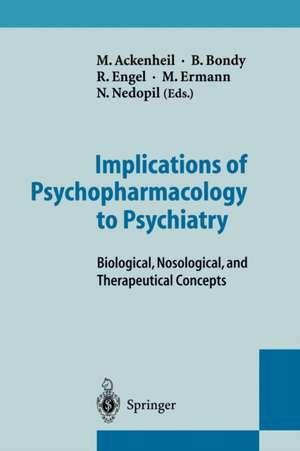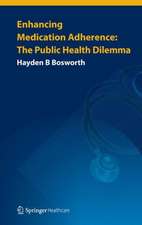Implications of Psychopharmacology to Psychiatry: Biological, Nosological, and Therapeutical Concepts
Editat de M. Ackenheil, B. Bondy, R. Engel, M. Ermann, N. Nedopilen Limba Engleză Paperback – 26 sep 2011
Preț: 710.60 lei
Preț vechi: 748.00 lei
-5% Nou
Puncte Express: 1066
Preț estimativ în valută:
136.01€ • 141.45$ • 113.98£
136.01€ • 141.45$ • 113.98£
Carte tipărită la comandă
Livrare economică 13-27 martie
Preluare comenzi: 021 569.72.76
Specificații
ISBN-13: 9783642646836
ISBN-10: 3642646832
Pagini: 204
Ilustrații: X, 187 p.
Dimensiuni: 155 x 235 x 11 mm
Greutate: 0.29 kg
Ediția:Softcover reprint of the original 1st ed. 1996
Editura: Springer Berlin, Heidelberg
Colecția Springer
Locul publicării:Berlin, Heidelberg, Germany
ISBN-10: 3642646832
Pagini: 204
Ilustrații: X, 187 p.
Dimensiuni: 155 x 235 x 11 mm
Greutate: 0.29 kg
Ediția:Softcover reprint of the original 1st ed. 1996
Editura: Springer Berlin, Heidelberg
Colecția Springer
Locul publicării:Berlin, Heidelberg, Germany
Public țintă
ResearchDescriere
The discovery of chlorpromazine for the specific treatment of schizophrenic symp toms and, later on, of imipramine for the specific treatment of depressive symptoms marked a new milestone in clinical psychiatry and basic neuroscience 40 years ago. The exploration of biochemical mechanisms of action of these psychotropic drugs created new theories on the pathophysiology of psychiatric disorders, such as the dopamine hypothesis of schizophrenia and the catecholamine and serotonin hypotheses of depression. Thus the discovery of these biological treatments had a major impact on natural science-oriented research. Biological psychiatry as we know it today has its origin in these psychopharmacological drugs and influences many disciplines in psychiatry. It was a fortunate coincidence that Hans Hippius, whose 70th birthday we celebrated this year with an international symposium, started his professional career during this time in the 1950S. He was one of the early pioneers in clinical psycho pharmacological research and enthusiastic about both the scientific and the thera peutic prospects of the new psychotropic drugs. He has worked in this field for more than three decades and has made many lasting contributions to biological psychiatry. Among the many activities, his contributions in the development of the new atypical antipsychotic drug clozapine should be mentioned.
Cuprins
Neurotransmitter Interactions Important for Schizophrenia.- The Etiology of Affective Illness.- New Findings in the Genetic of Bipolar Illness.- Targeting the Action of Antidepressant Drugs on Second-Messenger Systems.- New Concepts of Schizophrenia Derived from Epidemiological Research.- The Course of Psychiatric Disorders as a Diagnostic Tool.- A Psychonanalytic Model for the Classification of Personality Disorders.- Functional Pathology: An Essential Diagnostic Step in Biological Psychiatric Research.- The Development of Nosological Concepts in Anxiety Disorders.- Classification of the Affective and Related Disorders.- The Ideal Neuroleptic.- Long-Term Treatment of Schizophrenia.- Treatment of Affective Disorders.- Negative Symptoms of Schizophrenia: Methodological Issues, Biochemical Findings and Efficacy of Neuroleptic Treatment.- Interaction of Long-Term Antidepressant Treatment with Psychosocial Factors.
Textul de pe ultima copertă
The discovery of chlorpromazine 40 years ago and of other compounds for the specific treatment of psychiatric disorders had marked influence on clinical psychiatry and basic neuroscience. Since then, the development of psychopharmacology and theories of psychiatric disorders have become closely interrelated. On the occasion of the 70th birthday of Hanns Hippius - one of the pioneers of clinical psychopharmacology - leading experts in this field and related disciplines met to present and discuss their views and theories on psychiatric disorders. Future perspectives of drug development, genetic research in psychiatry, nosological and diagnostic concepts, and strategies for more specific treatment of various psychiatric disorders were presented. This was a unique occasion for most of the prominent and leading experts worldwide to contribute to this book. The reader is given broad insight into the research and clinical perspectives of psychiatry.










